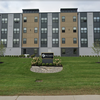Was Altamont undercounted in the latest census?
Altamont’s population has dropped by 45 since 2010. The number would have been higher had Altamont not taken over a portion of Guilderland in the ensuing decade. The Bozenkill Annexation, in the northeast part of the village, accounted for 35 residents in the latest census count.
ALTAMONT — The latest federal census figures show 45 fewer residents lived in the village in 2020 than a decade earlier, which could be construed as curious considering Guilderland’s population grew by 4.4 percent and Albany County’s by 3.5 percent over the same period — to say nothing of the 16 additional housing units that were built in that time.
So what gives?
That’s what former Mayor James Gaughan is trying to decipher.
Gaughan, who was village mayor from 2005 to 2017, spearheaded the local effort to ensure that every Altamont resident was included in the decennial census count.
Gaughan said approximately 30 households — and their residents — on Whipple Way, Sanford Place, and Western Avenue in the village were included as part of the town’s population.
If Gaughan is correct and those households were incorrectly included as part of the Guilderland census count, Altamont was shorted at least 71 residents, according to Albany County’s voter rolls.
Gaughan told The Enterprise by email that the map he saw was drawn in such a way that only the census tract outlines were visible; individual properties were not.
Gaughan could never get anyone at any level to confirm in which census tract those 30 households were ultimately located.
The Enterprise reached out to the Census Bureau on Aug. 24, providing a list of the 30 addresses in question but was informed the request would have to be passed on to the bureau’s Census Redistricting Office, and was told by Kristina Barrett, a public affairs specialist with the Census Bureau, “I cannot say how long it will take to process the request.”
As of Sept. 7, no response has been received.
But a January 2020 address count does clarify the picture some.
Approximately a dozen additional housing units appeared in 33 census blocks (Tract 146.12 had 29 blocks for the 2010 census) in a January 2020 address list count that weren’t there in an August 2021 update, when the 33 blocks and 741 housing units had been collapsed to 25 and 729, respectively.
Assuming the most up-to-date configuration of Census Tract 146.12, two of the census blocks — 1008 and 1009 — from the January 2020 count cover the area of the village about which Gaughan had raised questions.
Those two census blocks in the January 2020 count showed 95 housing units, while the August tally showed 50 units.
By the August count, it appears that about half of the housing units from Block 1008 were placed in Block 1002, which also covers the area in question, and which had zero listed housing units in the January 2020 count.
But Altamont’s 45-resident loss over the past decade, from 1,720 in 2010 to 1,675 in 2020, does raise other questions about the 2020 census count because the total number of housing units in the village increased from 713 to 729 and Guilderland, which Altamont is located entirely inside of, saw its population increase by 4.38 percent in that time, from 35,303 to 36,848.
The village’s population loss would have been even greater had Altamont not annexed a portion of Guilderland in the years in between the two decennial counts. In 2014, Altamont voted to extend its northeastern boundary, absorbing over 52 acres of Guilderland now known as the Bozenkill Annexation. In the latest census count, there were 35 residents living in the newest area of Altamont.
Without the Bozenkill Annexation, the village would have had a 4.7-percent loss in population over the past decade — just nine of the 25 census blocks that make up Altamont saw population growth between 2010 and 2020.
The largest increase occurred in the village block bounded by Maple Avenue, Lark Street, and Lincoln Avenue, and Western Avenues, which saw a 12-resident bump, from 32 in 2010 to 44 in 2020.
Four of the five most-populous census blocks — two in the area of concern raised by Gaughan and three in the portion of the village bounded by Bozenkill Road, Maple Avenue, Main Street, Altamont Boulevard, and the the village boundary with Guilderland — where nearly a quarter of village residents live, saw double-digit population decline over the past decade, an aggregate loss of 88 people, from 502 in 2010 to 414 in 2020, a 17.5-percent loss.
The other nine census blocks that lost population saw an aggregate decline of 4.5 percent between 2010 and 2020, from 817 in 2010 to 780 in 2020.
Why the loss?
Gaughan noted there was a political aspect to this year’s resident count: Former President Donald Trump’s handling of the 2020 Census.
Stopping the process earlier than normal may have left village residents uncounted, Gaughan said.
The final step of the census count was not conducted this year, according to Gaughan; that’s where workers would have knocked on doors and asked if they knew how many people lived in the neighboring house that never answered the census survey in the first place.
There are also just demographics.
The number of people living alone has gone up by an estimated 5.5 percent over the decade, from 26.8 percent of all households in 2010 (and up from 22 percent in 2000) to an estimated 32.3 percent in 2019, the most recent year of available census data, an increase of about 44 one-person households — the number of occupied households in the village went from 657 in 2010 to an estimated 683 in 2019.
The Census Bureau said there were 729 housing units in Alamont in 2020 — 698 occupied and 31 unoccupied; detailed household demographic data on the village for last year was not available. If the 2019 estimate held, 225 of Altamont’s nearly 700 occupied households last year would have had a single resident.
People are also having fewer children.
Over a generation, the number of residents in Altamont over the age of 18 increased from 1,215 in 2000 to 1,326 in 2010 to 1,329 in 2019, while the 17 years-and-under population dropped, from 522 (out of 1,737) in 2000 to 394 (out of 1,720) in 2010 to 346 (out of 1,675) in 2020.



